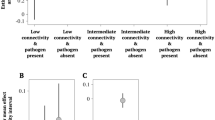Summary
The genetic polymorphism maintained by host-pathogen coevolution is analysed in a multilocus model. The model assumes gene-for-gene interactions of the type commonly observed between host plants and their fungal pathogens. Unstable (epidemic) systems maintain more resistance genes, fewer virulence genes, and less overall genetic diversity than stable (endemic) diseases. The stability of the system depends primarily on demographic parameters, such as the pathogen's intrinsic rate of increase, rather than genetic parameters, such as the costs of resistance and virulence. At equilibrium the model predicts that the number of resistance alleles in each host plant follows a binomial distribution that depends on the cost to the pathogen for carrying virulence alleles. Similarly, the number of virulence alleles in each pathogen spore follows a binomial distribution that depends on one minus the cost to the host for carrying resistance alleles. Data from wild populations match the predicted binomial distributions.
Similar content being viewed by others
References
Agrios, G. N. (1988)Plant Pathology, 3rd edn, Academic Press, NY, USA.
Barrett, J. A. (1985) The gene-for-gene hypothesis: parable or paradigm. InEcology and Genetics of Host-Parasite Interactions. (D. Rollinson and R. M. Anderson, eds) pp. 215–25. Academic Press, New York.
Burdon, J. J. (1987a)Diseases and plant population biology. Cambridge University Press, Cambridge, UK.
Burdon, J. J. (1987b) Phenotypic and genetic patterns of resistance to the pathogenPhakopsora pachyrhizi in populations ofGlycine canescens.Oecol. 73, 257–67.
Burdon, J. J. and Jarosz, A. M. (1992) Temporal variation in the racial structure of flax rust (Melampsora lini) populations growing on natural stands of wild flax (Linum marginale): localversus metapopulation dynamics.Plant Pathol. (in press).
Burdon, J. J., Jarosz, A. M. and Kirby, G. C. (1989) Pattern and patchiness in plant-pathogen interactions—causes and consequences.Ann. Rev. Ecol. Syst. 20, 119–36.
Burdon, J. J., Brown, A. H. D. and Jarosz, A. M. (1990) The spatial scale of genetic interactions in host-pathogen coevolved systems. InPests, Pathogens and Plant Communities. (J. J. Burdon and S. R. Leather, eds) pp. 233–47. Blackwell, Oxford, UK.
Callow, J. A. (1987) Models of host-pathogen interaction. InGenetics and Plant Pathogenesis. (P. R. Day and G. J. Jellis, eds) pp. 283–95. Blackwell, Oxford, UK.
Clarke, D. D., Campbell, F. S. and Bevan, J. R. (1990) Genetic interactions betweenSenecio vulgaris and the powdery mildew fungusErysiphe fischeri. InPests, Pathogens and Plant Communities. (J. J. Burdon and S. R. Leather, eds) pp. 189–201. Blackwell, Oxford, UK.
Crill, P. (1977) An assessment of stabilizing selection in crop variety development.Ann. Rev. Phytopath. 15, 185–202.
Day, P. R. (1974)Genetics of Host-Parasite Interaction. W. H. Freeman, San Francisco, USA.
Dinoor, A. and Eshed, N. (1987) The analysis of host and pathogen populations in natural ecosystems. InPopulations of Plant Pathogens: Their Dynamics and Genetics. (M. S. Wolfe and C. E. Caten, eds) pp. 75–88. Blackwell, Oxford, UK.
Flor, H. H. (1956) The complementary genic systems in flax and flax rust.Adv. Genet.,8, 29–54.
Flor, H. H. (1971) Current status of the gene-for-gene concept.Ann. Rev. Phytopath. 9, 275–96.
Frank, S. A. (1989) The evolutionary dynamics of cytoplasmic male sterility.Am. Nat. 133, 345–76.
Frank, S. A. (1991a) Ecological and genetic models of host-pathogen coevolution.Heredity 67, 73–83.
Frank, S. A. (1991b) Spatial variation in coevolutionary dynamics.Evol. Ecol. 5, 193–217.
Frank, S. A. (1992) Models of plant-pathogen coevolution.Trends Genet. (in press).
Gabriel, D. W. and Rolfe, B. G. (1990) Working models of specific recognition in plant-microbe interactions.Ann. Rev. Phytopath. 28, 365–91.
Groth, J. V. and Roelfs, A. P. (1982) The effect of sexual and asexual reproduction on race abundance in cereal rust fungus populations.Phytopathology 72, 1503–7.
Groth, J. V. and Roelfs, A. P. (1987) Analysis of virulence diversity in populations of plant pathogens. InPopulations of Plant Pathogens: Their Dynamics and Genetics. (M. S. Wolfe and C. E. Caten, eds) pp. 63–74. Blackwell, Oxford, UK.
Hamer, J. E. (1991) Molecular probes for rice blast disease.Science 252, 632–3.
Harry, I. B. and Clarke, D. D. (1986) Race-specific resistance in groundsel (Senecio vulgaris) to the powdery mildewErysiphe fischeri.New Phytol. 103, 167–75.
Jarosz, A. M. and Burdon, J. J. (1990) Predominance of a single major gene for resistance toPhakopsora pachyrhizi in a population ofGlycine argyrea.Heredity 64, 347–53.
Jarosz, A. M. and Burdon, J. J. (1991) Host-pathogen interactions in natural populations ofLinum marginale andMelampsora lini: II. Local and regional variation in patterns of resistance and racial structure.Evolution (in press).
Leonard, K. J. and Czochor, R. J. (1980) Theory of genetic interactions among populations of plants and their pathogens.Ann. Rev. Phytopath. 18, 237–58.
Magurran, A. E. (1988)Ecological Diversity and its Measurement. Princeton University Press, Princeton, USA.
May, R. M. (1974)Stability and Complexity in Model Ecosystems, 2nd edn, Princeton University Press, Princeton, USA.
Nelson, R. R. (1973) The use of resistance genes to curb population shifts in plant pathogens. InBreeding Plants for Disease Resistance. (R. R. Nelson, ed) pp. 49–66. Pennsylvania State University Press, University Park, USA.
Parker, M. A. (1985) The pleiotropy theory for polymorphism of disease resistance genes in plants.Evolution 44, 1872–5.
Parlevliet, J. E. (1981) Stabilizing selection in crop pathosystems: an empty concept or a reality?Euphytica 30, 259–69.
Person, C. (1959) Gene-for-gene relationships in host:parasite systems.Can. J. Bot. 37, 1101–30.
Seger, J. (1988) Dynamics of some simple host-parasite models with more than two genotypes in each species.Phil. Trans. R. Soc. Lond. B 319, 541–55.
Thompson, J. N. (1988) Variation in interspecific interactions.Ann. Rev. Ecol. Syst. 19, 65–87.
Vanderplank, J. E. (1984)Disease Resistance in Plants, 2nd edn, Academic Press, NY, USA.
Author information
Authors and Affiliations
Rights and permissions
About this article
Cite this article
Frank, S.A. Coevolutionary genetics of plants and pathogens. Evol Ecol 7, 45–75 (1993). https://doi.org/10.1007/BF01237734
Issue Date:
DOI: https://doi.org/10.1007/BF01237734




